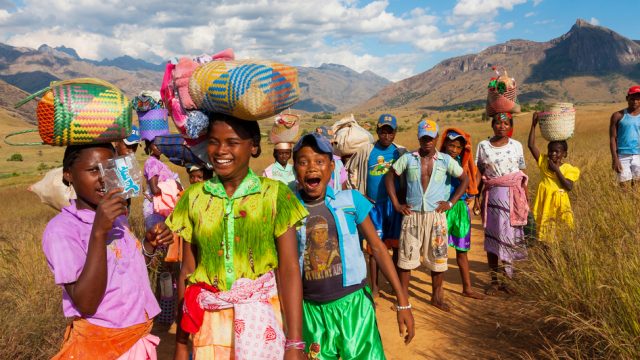When it comes to off-the-beaten path travel, Madagascar ranks as one of the world’s most intriguing destinations. Cast adrift from Africa some 165 million years ago, the planet’s fourth largest island has been evolving on its own terms ever since. As a result, the island boasts topography and animals found nowhere else on earth. But beyond the spiny octopus trees and 1000-year-old bobble head baobabs, the vanilla pods and rock spindle forests, the big-eyed lemurs and fuzzy tailed sifakas, the country is also a dream destination and fully understanding Madagascar culture will be quite the task.
Budding anthropologists can’t help but be fascinated by Madagascan/Malagasy culture, which is as unique — and at times downright strange — as its scenery. Although geographically closer to Africa than Asia, island people do not consider themselves African nor do they identify with the rituals of the mainland. The descendants of Indian and Malaysian seafarers who discovered this Noah’s Ark in the Indian Ocean two millennia ago and never left, the Malagasy people have developed their own traditions over the centuries.
In general, the Malagasy come across as unfailingly polite and incredibly reserved – they aren’t likely to inundate you with small talk or ask personal questions. For many visitors, this reserve may feel like outright snobbery, but locals told me not to take it personally.
“Some things are just not acceptable for discussion in polite company,” my driver Roger confided to me in French after a couple of Three Horse beers at our hotel. “If you have trouble with your spouse, or you have to borrow money from the bank, these are just not things you would ever speak about in Madagascar. I think it is different in America the customs yes?”
“I think so,” I responded. “I mean if I had a financial problem, I would confide to a close friend about it in hopes that we could find a solution together. Or sometimes just to talk it out.”
Roger shook his head. In his country, this kind of conversation was considered tacky. And should I have dared to ask this same friend about her relationship with a man, for instance, it would be considered even more fady (Malagasy for taboo). I learned asking pointed questions aren’t the only things that are taboo here.
In some areas, Roger confided, indoor plumbing is considered disgusting and you won’t find toilets inside houses, while in others, it is taboo to talk about crocodiles or whistle on a particular stretch of beach. These fady were created as a way to respect the ancestors. Since many of the actions such as walking past a sacred tree, swimming in a certain river, or even eating pork seem harmless to Westerners and also vary from village to village, there are certain things you have to do. To avoid angering the ancestors or insulting your host, it is best to ask locals what is considered okay and what is not allowed in each place you visit. Be particularly careful in the vicinity of tombs and burial sights, which are considered highly sacred everywhere.
Regardless of where you travel in Madagascar, you’ll see that family plays a central theme. This includes not only your immediate family, but also distant cousins and departed ancestors. The later make an appearance during the Famadihana ceremonies. Literally the “turning of the bones,” this sacred ritual takes place every year between June and September in the Central Highlands region.
During the ceremony, family members exhume the bodies of deceased loved ones, gently wrap them in straw mats and dance in a merry throng, carrying their dead relatives above their heads. A period of quiet is followed, where family members hold the bodies of their loved ones in their laps. Many sit silently and weep, but the general feeling is not one of sadness, but simply of loss. It is usual to give the dead tastes of homemade rum, and for sons and daughters to catch their parents and grandparents up on the local gossip. This is also a time to take family photographs, and it is common to see people lining for iPhone photos with the shroud-wrapped bodies of their deceased family members in the foreground. Although the ceremony takes place annually, family members are not exhumed each year, but rather every seven. After sitting quietly with their dead, family members re-wrap the bodies in pristine white burial clothes that are sprayed with perfume and meticulously labeled by name with felt-tip markers. They then dance the dead one more time around the tomb and a few traditional verses are spoken before the bodies are returned to the tombs and the stone is sealed with mud for another seven years.
If you are visiting during the right time of year, and are lucky enough to be invited to participate in a ceremony, it will likely be the most enlightening portion of your trip. If you want to attend, but don’t have an invite, ask around the Central Highlands towns along the Route du Sud (the island’s main north-south road). Most Malagasy are not opposed to foreigners attending the festivities, but make sure to bring a bottle of rum for the family as a token of appreciation.
“If you don’t want to commit a fady, this is just something you do,” Roger said, as we drove past a group of family members hoisting their dead relatives above their heads. Their feet were moving to the rhythm of a beat I couldn’t hear through the minivan’s revving engine, but their cheerful emotions were evident through the dust smeared windows. In Madagascar, after all, I learned, death is not viewed as something negative, nor is it seen as a final event. It is simply a transition from one world to another, and for this reason, there is no shame in speaking and laughing with the dead as if they are still alive.



